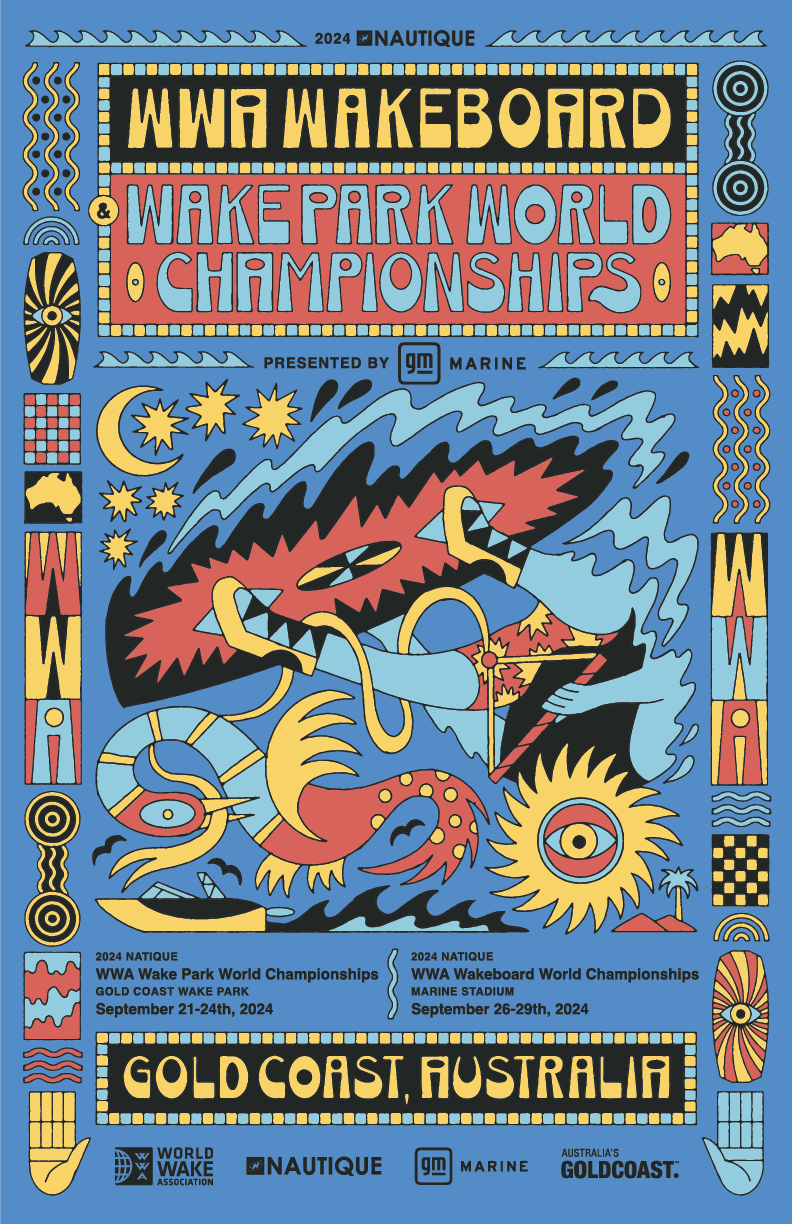WWA Standard Wakesurf Format:
Overview:
Riders will perform a subjectively judged two-pass run, where the boat will travel each pass in a straight path along the course in each direction. Each Rider will be scored on the total use of the course.
Contestants may perform any number of tricks they choose, in any order they wish within the course unless specified by the chief judge. Riders will be judged on the difficulty and proficiency of the moves executed, how big they take tricks, variety of tricks performed, technical difficulty, and the creativity and fluidity of the run.
The Course:
The course should be between approximately 750′ to 900′ or 230-275 meters long which is about 45-60 seconds, marked at either end of the water by boat course buoys. There will also be a fall buoy positioned three quarters of the way along the course on the second pass. It is the contestant’s responsibility to be aware of where these buoys are located at each event. The event organizer and/or chief judge may opt not to use the ¾ buoy.
The Run:
The rider will leave the starting point and scoring will begin when the boat reaches the first course buoy. At the end of the first pass, the boat will turn after passing the end course buoy to drop the rider, turn around and re-enter the course. Riders will be judged on tricks initiated within the course. Riders may initiate a move prior to the buoy but must land or complete the move near or at the buoy to receive credit for the trick. There must be a majority by all scoring judges to discredit a move for “out of course”. Riders must be ready for the boat to turn immediately after the second course buoy. No re-rides will be awarded for the boat turning or stopping during a trick at the ends of the course.
The rider will continue their run after their first and second wake fall from the place they fell, unless the fall occurs after the ¾ fall buoy. A third wake fall finishes the run immediately.
Each contestant is free to perform tricks in whatever order they desire as permitted in their division. There is no maximum or minimum number of tricks required, although riders are encouraged to perform big, clean, well executed, powerful tricks. Riders should emphasize quality over quantity, while demonstrating the range and limits of their abilities. These abilities should include, but are not limited to, performing a variety of moves, taking each move to its limit, and showing creativity and fluidity in the routine. Every trick the rider performs will be evaluated in the scoring of the routine. Each contestant will be judged only against the other riders in the heat, using the subjective categories ONLY to arrive at a single combined score.
Communication:
It is the sole responsibility of the rider to communicate to the driver before leaving the dock to verify the proper speed of the boat. Riders must also communicate any specifics i.e.…side of the wake that will be surfed, transfers, etc. There will be NO re-rides due to miscommunication.
Falls:
A rider may have one out of course fall only before the start of his/her first pass. A fall between the first and second pass, being the first out of course fall, may also be used as the riders out of course fall. A rider may switch boards between courses.
Each rider may also have one handle throw before the start of his/her first pass. This will count as their one out of course fall. A rider attempting a trick out of the course will count as an in course fall. The out of course fall cannot be used as a warm up.
A rider can have a maximum of three falls during a run. A third fall will end the run. Should a fall occur, the driver will pick up the rider as quickly as possible. The rider will not be picked up after a fall that occurs beyond the three quarters point of the second pass. The point after which a rider will not be picked up will be clearly marked with a buoy. Upon a third wake or ¾ buoy fall, the run is over and the boat will return to the starting point.
Judging:
Each contestant shall be judged on one complete, individual run. That run will be compared against other runs from the same heat and ranked only against those runs. There are no predetermined points for any tricks. The judging of this routine begins when the rider leaves the dock and ends when:
a)The time/run allotted expires
b)The rider reaches the maximum number of falls allowed
Scoring:
There will be three judges all writing down the riders run. Each judge’s score will be worth 33.3 percent of the overall score. The judge will give each rider a score from 1 to 10 taking into account the D.R.I.V.E criteria. The three judges scores will be averaged together to come up with an overall score out of 100. There will be no predetermined values for placing. Each judge will analyze the rider’s runs based off of the DRIVE criteria and score them appropriately. Judges will be able to reward as well as penalize riders according to the performance of their runs.
D – difficulty
R – risk
I – intensity
V – variety
E – execution
Difficulty:
Trick difficulty (Technical Difficulty) – This is simply defined as how difficult each trick is based on a number of variables. Spins, carves, turns, airs, grabbing your board and the way a rider lands all subjectively define how difficult certain tricks are in comparison to others.
- Number of rotations
- Combos (combining tricks, adding spins, grabs etc)
- The direction a rider spins in relation to the trick. Frontside or backside (blind)
- Switch vs. regular stance
- Grabbed or not
Risk:
- Linking difficult tricks
- Trick difficulty in relation to the course.
- Speed, Power and Flow of trick(s)
- A rider opening their run with a technically difficult trick would be considered high risk.
Risk is also demonstrated by how a rider performs their tricks and whether or not they display a sense of “putting it all on the line” in order to better their opponents.
Intensity:
Judges look for how big or high the rider is taking each of their tricks as well as the speed, power and commitment that goes into the trick. This is typically noted on the judges sheet by a plus sign, “+”. If the trick was incredibly powerful, and the judge will place 2 plus signs next to it on the judges sheet, “+ +”. The same goes for tricks done small or weak may have a minus “-“ sign.
Variety:
- A variety of tricks performed in a pass is what judges are looking for in order to determine the most versatile rider. Wakesurfing has categories of tricks such as: airs, turns, carves, tech tricks, etc. Surfing both frontside and backside as well as switch and regular. A good wakesurf pass should have tricks from each of these categories and be well rounded. This shows a rider is skilled at all types of maneuvers and therefore showing variety in their riding.
- Were the tricks all based on the same trick?
- Were the grabs different?
- Did the rider spin both directions?
- Did the rider show more than one ‘style’ of wakesurfing?
Execution:
- Completion of the Trick – This is essentially how the trick was performed and that the rider is in control. Control and poise during the middle of a trick shows the rider is confident in that trick and thus it is well executed. Control and completion of a trick also means that the rider is performing a trick he/she set out to complete. Example: If a rider attempts to do a 360 and bobbles halfway through the trick and over-spins it shows they are not in control.
- The Landing/Trick execution – This is simply how clean the landing/completion was of the trick. If the rider butt-checks, drags a hand, over rotates to avoid falling, or looks out of control after they have completed a trick this can negatively affect the execution category.
- Perfection – Judges are looking for how “clean” or how perfect EACH trick was performed in the passes. Judges look at the approach, the body position, rotation of the trick, the axis of the body, head position, clean grabs not slaps, speed to which the trick was performed. A rider completing their routine without falling also demonstrates perfection.
- FLOW: Flow is when a wakesurfer can execute their tricks together to make them look like they connect smoothly from one to another. For instance, when a rider lands a trick switch and then approaches the wake to do the next trick in the same switch position. A rider that does not flow well would do things like constantly hopping from switch to regular or vice versa in their transition between tricks, starting the pass late, or finishing a pass early. Dead water is not showing flow or composition.
- Did the rider customize or adapt tricks…make them their own?
General:
Creativity of course management and time is crucial in achieving a smooth, fluid, flowing run. Riders that take the time to plan out their run, plan the path they are going to take will be rewarded in this area. Riders that can link creative tricks/maneuvers will also be rewarded. Judges will be looking for riders that use up the full time, and length of the course. Wasted water will reflect negatively towards the rider’s score.
Judges will only score tricks successfully landed. If a rider falls out of the wave after a trick a majority from the judges will determine if the trick counts. In general if a rider comes back forward on the wave after completing a trick it will count as landed, however, execution will be considered. Falls are simply a missed trick and course time is lost. You will not be judged down for falls, but this can take away from the overall look and flow of a riders run. Riders are allowed 2 falls. The run ends on 3rd fall. Riders may use two different boards in their run. Boards may be swapped between passes or during a pick up from a fall. Riders may request transfers on the waves at any point during their run. There is no limit to the number of transfers. There will be no re-rides for miscommunications on transfers.
Event Seeding:
Example of pattern of heats:
Heat #1: Seeds 6, 7, 18, 24, 25 (running order; you reverse seeds so higher seed go last)
Heat #2: Seeds 5, 8, 17, 23, 26 (running order; you reverse seeds so higher seed go last)
Heat #3: Seeds 4, 9, 16, 22, 27 (running order; you reverse seeds so higher seed go last)
Heat #4: Seeds 3, 10, 15, 21, 28 (running order; you reverse seeds so higher seed go last)
Heat #5: Seeds 2, 11, 14, 20, 29 (running order; you reverse seeds so higher seed go last)
Heat #6: Seeds 1, 12, 13, 19, 30 (running order; you reverse seeds so higher seed go last)
Other numbers of competitors are determined with the same format.
*Riders in all divisions will first be seeded off the current Nautique Wakesurf Series Ranking followed by all other riders at random. Riders will be input into the scoring system based on their placement in their division on the ranking. Any ties will first be broken by the most recent event. If a tie cannot be broken it will be determined randomly by the computer system for seeding.
In the preliminary rounds, positions are determined by the Athlete’s seeding numbering, which is determined by the ranking list and/or criteria used by the event organizer. All riders must compete in the order of the posted running order. If an athlete rides out of order his/her scores with not be counted.
Semifinal and Final round seeding are determined by position finish in the previous round. If both had the same identical final position in the previous round, you would go back to round before that, and round before that before going to the seeding on the original running order used for the qualifying round. (For example, if rider A and rider B both finish first in their heats in the semifinals, and you had to determine who was the top seed in the finals, you would go the quarterfinals finish, if both A and B finished first there also, you would go back to the seeding on the original running order used for the quarterfinals.)





